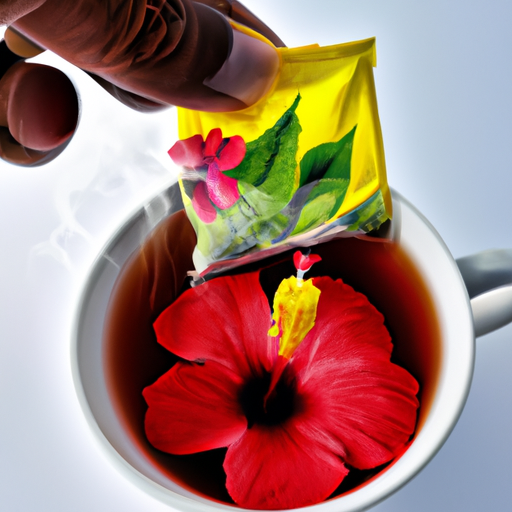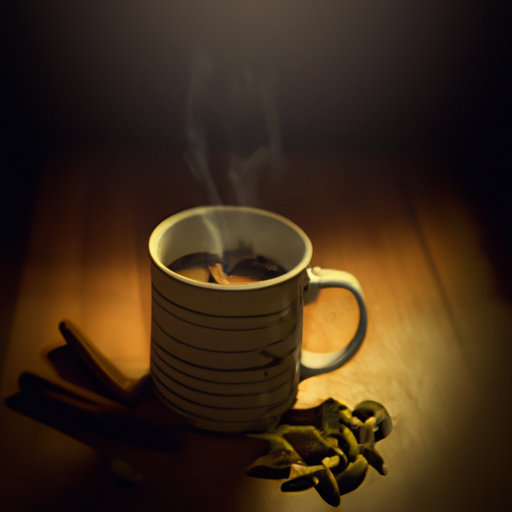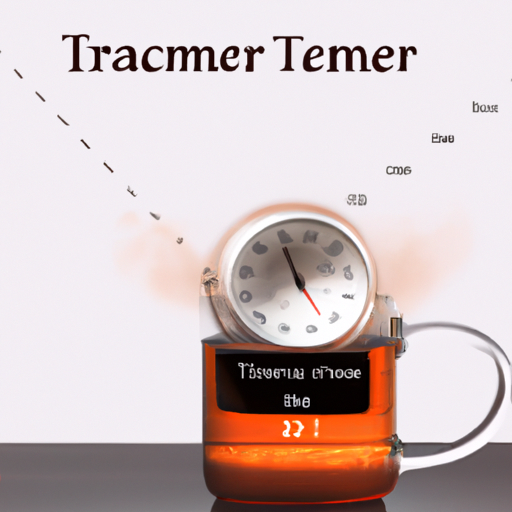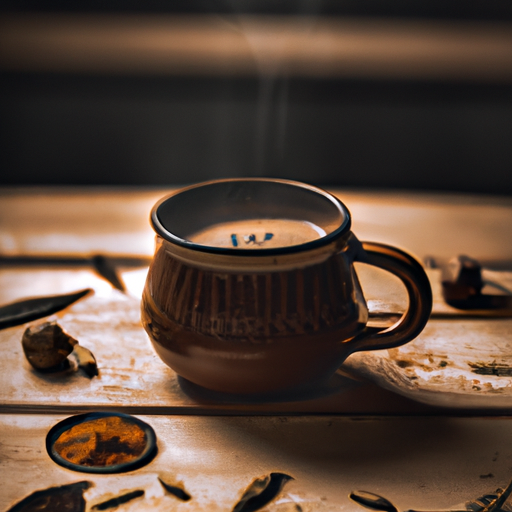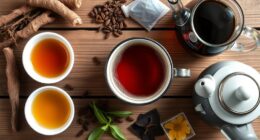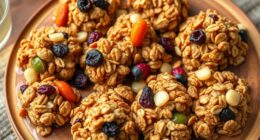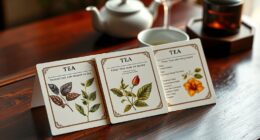I’m totally fond of chilled chai tea, particularly in the summertime. It’s the ideal beverage to help you cool off when it’s warm outside, all the while offering that cozy and spicy flavor of chai.
Making it at home is surprisingly easy, and Im here to share my step-by-step guide on how to make the perfect iced chai tea.
To start off, youll need some basic ingredients such as black tea bags, spices like cinnamon and ginger, sweeteners like honey or sugar, milk or cream, and ice cubes.
Once you have all your ingredients ready, its time to brew your tea. The key to a good iced chai is a strong brewed base with plenty of spices added in for flavor.
So get ready to indulge in this delicious beverage by following these simple steps!
Key Takeaways
- Choosing the right spice blend is important for an elevated flavor profile in iced chai tea.
- Sweeteners can enhance the taste of the tea and can be substituted with healthier options.
- Any type of milk, including vegan alternatives, can be used in making iced chai tea.
- Iced chai tea has numerous health benefits, including antioxidant properties and promotion of digestive health.
Gather Your Ingredients
You’re gonna love gathering all the ingredients for your delicious iced chai tea!
First, you’ll need to choose a spice blend that suits your taste buds. You can either purchase pre-made blends or create your own using cinnamon, cardamom, ginger, and cloves. These spices will add warmth and depth to your beverage.
Next, decide on an alternative sweetener to use in place of traditional sugar. Honey is a popular choice because it adds a subtle sweetness without being overpowering. Maple syrup and agave nectar are also great options that offer unique flavor profiles.
Don’t forget the most important ingredient – black tea! Choose a high quality loose leaf tea or opt for tea bags if you prefer convenience.
Now that you have gathered all the necessary ingredients, it’s time to brew your tea and start preparing your refreshing iced chai drink.
Brew Your Tea
Brewing the perfect cup of iced chai tea requires patience and attention to detail. The first step is to select your favorite loose-leaf or bagged black tea variety, such as Darjeeling or Assam. Next, boil water in a kettle or on the stove until it reaches the ideal temperature for your chosen tea type. Steep the tea for three to five minutes, stirring occasionally with a spoon to ensure even flavor extraction.
To create an authentic chai flavor profile, consider adding spices during the brewing process. Here’s a table of common chai spices and their recommended measurements:
| Spice | Measurement |
|---|---|
| Cinnamon | 1-2 sticks or 1 tsp ground |
| Ginger | Fresh grated or 1 tsp ground |
| Cardamom | 3-4 pods or ½ tsp ground |
| Cloves | 3-4 whole cloves or ¼ tsp ground |
| Black Pepper | A pinch |
After steeping your tea and spices together, remove any solids from the liquid using a strainer. If you prefer sweeter drinks, add honey or sugar to taste while the mixture is still hot. Allow the spiced tea concentrate to cool before pouring over ice and serving.
Adding spices gives your homemade chai its unique character and depth of flavor. In the next section, I’ll show you how to balance those flavors with dairy milk and non-dairy alternatives for a creamy finish that complements any mealtime occasion.
Add Spices
When it comes to making a delicious iced chai tea, adding the right spices is crucial. As someone who’s experimented with different spice blends over the years, I can confidently say that there are a few common spices that work best in this drink.
In this discussion, I’ll share my experience and knowledge on the topic and offer tips on how much spice to add for optimal flavor.
Common Spices Used in Iced Chai
To get that perfect iced chai flavor, all you need are the warm and inviting spices of cinnamon, cardamom, and cloves. These flavorful combinations have been used in traditional chai recipes for centuries. Each spice brings its unique taste to the table – cinnamon adds warmth, cardamom gives a citrusy note, while cloves add a rich depth of flavor.
Here’s a helpful table outlining the common spices used in making iced chai:
| Spice | Flavor Profile | Amount Used |
|---|---|---|
| Cinnamon | Warm and sweet | 1 tsp |
| Cardamom | Citrusy and floral | 1/2 tsp |
| Cloves | Rich and spicy | 1/4 tsp |
Incorporating these spices in your homemade iced chai will give it that authentic aroma and taste that can’t be replicated by store-bought versions. But how much spice should you add? Let’s find out in the next section.
How Much Spice to Add
You’ll want to sprinkle just the right amount of each spice to achieve that perfect balance of flavors in your homemade iced chai. Spice selection is key when creating a well-rounded and authentic Chai flavor.
It’s important not to overdo it with any one spice, as this can result in an overpowering taste that masks the other flavors. Start by adding a small amount of each spice – usually around 1/4 teaspoon for every cup of tea – and then adjust according to your personal taste preferences.
Some people prefer their chai to be more cinnamon-heavy, while others may lean towards a stronger cardamom flavor. The beauty of making your own iced chai is that you have full control over the spice ratios, so feel free to experiment until you find the perfect blend.
Once you’ve got your spices all measured out and ready to go, it’s time to move on to sweetening your tea. Remember, getting just the right combination of spices is crucial for achieving that delicious Chai flavor in your iced tea!
Sweeten Your Tea
Adding a sweetener like honey or agave will enhance the flavor of your iced chai, and don’t worry about it being too sugary – you can always adjust to taste. Here are some tips on how to sweeten your tea:
-
Best sweeteners: Honey and agave are great options because they blend well with the spices in the chai. They add a subtle sweetness without overpowering the other flavors.
-
Alternatives to sugar: If you prefer something less traditional, try using maple syrup or coconut sugar instead of granulated sugar. These natural alternatives provide a unique flavor profile that complements the chai spices.
-
Amount to use: Start with one teaspoon of sweetener per cup of tea, and adjust as needed for taste preference.
-
Mixing technique: To ensure that your sweetener dissolves evenly, mix it into hot water before adding it to your iced tea.
Once you’ve added your desired amount of sweetener, it’s time to move on to adding milk or cream for an extra creamy texture and rich flavor.
Add Milk or Cream
Now it’s time to take your iced chai to the next level by incorporating milk or cream for a smooth and indulgent taste that will leave you wanting more. Adding milk or cream to your iced chai is a great way to balance out the spices and sweetness in the tea.
You can use any type of milk that you prefer, such as whole milk, almond milk, soy milk, or coconut milk. Each type of milk will provide a unique flavor profile, so feel free to experiment with different types until you find one that suits your taste buds.
If you’re looking for a vegan alternative to traditional dairy-based creamers, there are plenty of options available. Coconut cream is an excellent choice because it has a creamy texture and adds a subtle coconut flavor that pairs well with the spices in chai tea. Other vegan alternatives include almond or cashew cream, which also have a rich and creamy texture.
Once you’ve added your preferred type of milk or creamer to your iced chai tea, give it a good stir to ensure that everything is mixed together evenly.
Now we move on to another important step – chilling your tea!
Chill Your Tea
To achieve a refreshing and satisfying drink, it’s essential to let your spiced beverage cool down before enjoying it fully. There are different ways to chill your tea, depending on your preference and time constraints.
One option is to pour the freshly brewed chai over ice cubes and let them melt slowly, diluting the flavor slightly but keeping the temperature low. Another method is to refrigerate the tea for a few hours or overnight, allowing it to steep further and develop more complexity.
If you want to experiment with ice types and brewing methods, here are some ideas to try out:
- Use flavored ice cubes: instead of plain water, freeze some coconut milk or almond milk in an ice cube tray and use those cubes in your iced chai for an extra creamy texture.
- Cold brew your tea: steep the chai in cold water overnight or for at least 4 hours in the fridge, then strain it and add sweetener if desired. This method yields a smoother and less bitter taste than hot brewing.
- Double-brew your tea: make a concentrated batch of hot chai by using more spices and less water than usual. Let it cool down before pouring it over ice or refrigerating it. This way, you’ll get a stronger flavor that won’t get diluted as much.
Once you’ve chilled your tea according to your liking, you can move on to serving it with garnishes such as whipped cream, cinnamon sticks, or honey drizzle. It’s important not to skip this step since adding toppings enhances both the appearance and taste of iced chai.
Serve Your Iced Chai
When serving your refreshing spiced beverage, don’t forget to have some fun with the presentation! Creative presentation can make a huge difference in how much you enjoy your drink.
You can add color and character to your glass by using colorful straws, fruit slices, or even edible flowers for an Instagram-worthy drink. One of the best garnishing options for iced chai is fresh mint leaves. Not only do they add flavor and aroma to your tea, but they also lend a beautiful green hue that complements the warm spices in the chai mix.
Alternatively, if you prefer a sweeter taste, you can use cinnamon sticks or honey drizzles as additional toppings. With these creative presentation ideas and garnishing options at hand, it’s easy to take iced chai from ordinary to extraordinary.
But why stop there? There are many other ways to customize this classic beverage according to your preference. Stay tuned for our next section on exciting iced chai variations that will surely spice up your life!
Iced Chai Variations
Indulging in a creamy and flavorful iced chai can satisfy your sweet tooth cravings and perk up your day, but have you ever tried adding unique ingredients to spice things up? There are endless ways to customize your iced chai tea.
Here are three variations to try:
-
Spice blends: Adding different spice blends can elevate the flavor profile of your iced chai. Try mixing in cinnamon, nutmeg, ginger, or cardamom for a warm and comforting taste.
-
Non-dairy options: If you’re lactose intolerant or vegan, there are plenty of non-dairy alternatives that can replace traditional milk in your iced chai. Almond milk, soy milk, oat milk, or coconut milk all work well and add their own unique flavors.
-
Sweeteners: Instead of using plain white sugar to sweeten your iced chai, try experimenting with honey, maple syrup, agave nectar, or even stevia for a healthier option.
Customizing your iced chai tea is not only fun but also allows you to cater to personal preferences and dietary restrictions. Now that we’ve explored some delicious variations on this classic drink, let’s talk about the health benefits of indulging in this tasty treat!
Health Benefits of Iced Chai Tea
I love drinking iced chai tea, not only because of its delicious taste but also because of its health benefits.
One of the key benefits is its antioxidant properties, which can help reduce inflammation and protect against cellular damage.
Additionally, the spices used in chai tea, such as ginger, cinnamon, and cardamom, have digestive benefits that can aid in digestion and alleviate stomach discomfort.
Antioxidant Properties
You’ll be happy to know that iced chai tea is not only delicious, but it also has antioxidant properties that can help boost your health. Antioxidants are compounds that protect the body from damage caused by harmful molecules called free radicals. The spices in chai tea, including cinnamon, ginger, and cloves, are rich sources of antioxidants. These antioxidants have been found to reduce inflammation and oxidative stress in the body, which can lead to various diseases such as cancer and heart disease.
To understand the antioxidant benefits of iced chai tea better, take a look at this table:
| Spice | Antioxidant Capacity |
|---|---|
| Cinnamon | High |
| Ginger | Moderate |
| Cloves | High |
| Cardamom | Low |
| Black Pepper | Low |
As you can see, cinnamon and cloves have the highest antioxidant capacity among the spices commonly used in chai tea. Incorporating these spices into your diet through iced chai tea consumption can offer significant health benefits. In addition to its antioxidant properties, iced chai tea also provides digestive benefits due to its blend of herbs and spices.
Digestive Benefits
The blend of herbs and spices found in iced chai tea provides digestive benefits. Ginger is a key ingredient that has been shown to reduce nausea and improve digestion. It’s known for its ability to stimulate the production of digestive enzymes, which help break down food in the stomach and intestines. This can lead to improved gut health and overall digestion support.
In addition to ginger, the cinnamon found in chai tea has also been linked to improved digestion. Cinnamon helps regulate blood sugar levels, which can prevent spikes and crashes that may contribute to digestive issues. The combination of these ingredients makes iced chai tea not only a delicious treat but also a great choice for anyone looking to support their digestive system.
Frequently Asked Questions
Where can I find high-quality loose-leaf black tea for my iced chai?
When it comes to finding the best brands of loose-leaf black tea for your iced chai, there are plenty of online options to explore. Loose-leaf tea is known to be of higher quality than tea bags due to its larger size and better flavor retention.
Some popular high-quality brands include Harney & Sons, Teavana, and Adagio Teas. These companies offer a wide range of loose leaf teas that can be purchased online, making it easy to find the perfect one for your iced chai recipe.
Additionally, choosing loose-leaf tea over tea bags provides other benefits such as sustainability and a greater variety of flavors and aromas. So if you want the best possible taste for your iced chai, consider investing in some high-quality loose-leaf black tea from a reputable online retailer.
Can I use a different type of milk or cream instead of dairy milk?
I prefer using plant-based alternatives as a substitute for dairy milk when making iced chai tea. Not only do they add a unique flavor profile, but they also provide nutritional benefits such as being low in saturated fat and high in vitamins and minerals.
Some popular options include almond milk, coconut milk, oat milk, and soy milk. It’s important to note that different types of plant-based milks may alter the taste of the iced chai slightly, so it’s best to experiment with different options until you find one that suits your taste preferences.
Overall, incorporating plant-based alternatives into your diet can be a healthy and sustainable choice for both yourself and the environment.
How long can I store my brewed and chilled iced chai tea before it goes bad?
Isn’t it great when you spend time and effort making a delicious iced chai tea only to forget about it in the fridge for days, wondering if it’s still safe to drink? Well, fear not my fellow chai enthusiasts!
As someone who’s made this mistake one too many times, I can tell you that brewed and chilled iced chai tea can last up to five days in the refrigerator. However, there are some storage tips that can help prolong its shelf life.
First, make sure the container is airtight to prevent contamination from other foods or odors. Second, avoid adding any dairy or non-dairy milk until just before serving, as these tend to spoil faster than the tea itself. Finally, always use clean utensils when serving or brewing your tea to prevent any additional bacteria growth.
By following these simple steps, you can enjoy your homemade iced chai tea without worrying about its freshness!
Is it possible to make iced chai without using sugar or a sweetener?
Yes, it’s definitely possible to make iced chai without using sugar or any other sweetener. There are several alternative sweeteners for iced chai that can be used, such as honey, maple syrup, stevia, and agave nectar.
However, some people prefer to drink unsweetened iced chai because of the health benefits it offers. Unsweetened iced chai has lower calorie content and helps in reducing blood sugar levels. It also aids in digestion and boosts metabolism.
So if you want to enjoy the health benefits of chai tea without adding any extra calories from sugar or sweeteners, go ahead and try making an unsweetened version of this delicious beverage today!
Can I add other spices or flavorings to customize my iced chai tea?
When it comes to customizing my iced chai tea, I love experimenting with different spice blends and alternative sweeteners.
Adding a dash of cardamom or cinnamon can give the drink an extra kick of flavor, while using honey or agave syrup instead of traditional sugar can provide a healthier option.
The possibilities are endless when it comes to creating your own unique blend of spices and sweeteners. Don’t be afraid to get creative and try out new combinations until you find the perfect mix that satisfies your taste buds.
Conclusion
Making an iced chai tea is a refreshing way to enjoy this classic beverage. As I’m sipping on my own homemade iced chai, I’m reminded of the beauty in simplicity.
Just a few ingredients and a little bit of time can create something so delicious and satisfying. The spices in the chai represent the depth and complexity of life, while the coldness of the ice symbolizes change and transformation.
Sometimes we need to take a step back from our busy lives and indulge in something simple yet meaningful. Making an iced chai tea is just one way to do that, reminding us to pause, breathe, and appreciate the small pleasures in life.


